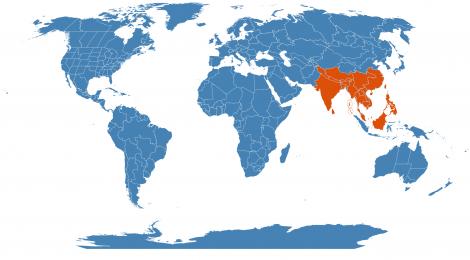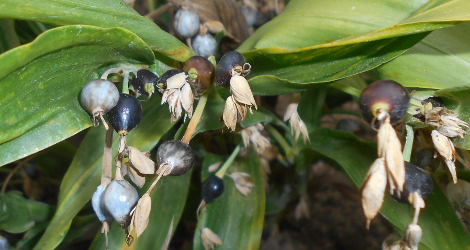Accession Data:
Coix lacryma-jobi L.
- Common Name: Job's Tears
- Family: Poaceae Barnh.
- Country of Origin: Indian Subcontinent to Taiwan and Pen. Malaysia

- Habitat: Wet places in grassland in the foothills of the Himalayas
- Description: This annual grass is native to south-east Asia and grows to a height of around 3 ft (1 m), with knobbly, bamboo-like stems from the bases of which new ‘tillers’ arise, these sometimes self- layering. The glossy deep green leaves are up to 2 in (5 cm) wide with slightly wavy edges. The flowering and fruiting spikelets are insignificant, but the shiny, pea-sized receptacles that enclose their bases harden in fall (autumn) to a pale bluish gray and have often been used for beads and other decorative purposes. Some selected strains are cultivated for their edible grains.
- Uses: The fruits are used in folk remedies for various tumors, esophageal, gastrointestinal, and lung cancers. This folk reputation is all the more interesting when reading that one of the active constituents of the plant, coixenolide, has anti-tumor activity. The seed, with the husk removed, is anti-rheumatic and tonic. A tea from the boiled seeds is drunk as part of a treatment to cure warts. It is also used in the treatment of respiratory difficulties and the treatment of cancer.6
In TCM, it is an herb known as Yi Yi Ren used to clear Dampness and inference with the digestive system. Assists in removing water retention as it promotes urination. The seeds are sometimes cooked or used as a flour/bread base. The roots have been used in the treatment of menstrual disorders.
- IMPORTANT NOTE: Plant Uses are for informational purposes only. EEB Greenhouses assume no responsibility for adverse effects from the use of any plants referred to on this site. Always seek advice from a professional before using any plant medicinally.
- USDA Zone: 9-12
Accession Data:
- Accession # 199800144
- Source: Smith College Index Seminum
- Accession Date: 09-30-1998
- Bench: 1201 - AUS:West Bench NN
- Currently: active - healthy
- Qty: 1 confirmed on 07-01-2025
Classification:
- Division: Magnoliophyta
- Class: Liliopsida
- SubClass: commelinids
- Order: Poales
- SubOrder:
- Family: Poaceae
- SubFamily: Panicoideae
- Tribe: Sacchareae
- SubTribe: Coicinae
Flowering Data:
This accession has been observed in bloom on:| Year | Jan | Feb | Mar | Apr | May | Jun | Jul | Aug | Sep | Oct | Nov | Dec | ||||||||||||||||||||||||||||||||||||||||
|---|---|---|---|---|---|---|---|---|---|---|---|---|---|---|---|---|---|---|---|---|---|---|---|---|---|---|---|---|---|---|---|---|---|---|---|---|---|---|---|---|---|---|---|---|---|---|---|---|---|---|---|---|
| 2025 | ||||||||||||||||||||||||||||||||||||||||||||||||||||
| 2024 | ||||||||||||||||||||||||||||||||||||||||||||||||||||
| 2023 | ||||||||||||||||||||||||||||||||||||||||||||||||||||
| 2022 | ||||||||||||||||||||||||||||||||||||||||||||||||||||
| 2021 | ||||||||||||||||||||||||||||||||||||||||||||||||||||
| 2020 | ||||||||||||||||||||||||||||||||||||||||||||||||||||
| 2019 | ||||||||||||||||||||||||||||||||||||||||||||||||||||
| 2018 | ||||||||||||||||||||||||||||||||||||||||||||||||||||
| 2017 | ||||||||||||||||||||||||||||||||||||||||||||||||||||
| 2016 | ||||||||||||||||||||||||||||||||||||||||||||||||||||
| 2015 | ||||||||||||||||||||||||||||||||||||||||||||||||||||
| 2014 | ||||||||||||||||||||||||||||||||||||||||||||||||||||
| 2013 | ||||||||||||||||||||||||||||||||||||||||||||||||||||
| 2012 | ||||||||||||||||||||||||||||||||||||||||||||||||||||
| 2011 | ||||||||||||||||||||||||||||||||||||||||||||||||||||
| 2010 | ||||||||||||||||||||||||||||||||||||||||||||||||||||
| 2009 | ||||||||||||||||||||||||||||||||||||||||||||||||||||
| 2008 | ||||||||||||||||||||||||||||||||||||||||||||||||||||
References (internal):
- Medicinal Plants
- Type Species
- EEB 3271 - Systematic Botany
- Medicinal Plants - Traditional Chinese Medicine
- Medicinal Plants - Digestive System
- Medicinal Plants - Respiratory System
- Medicinal Plants - Immune System
- EEB Greenhouse Holdings native to: China South-Central / Hainan / China Southeast / Tibet / Taiwan / Assam / Bangladesh / East Himalaya / India / Nepal / Sri Lanka / West Himalaya / Andaman Is. / Cambodia / Laos / Myanmar / Nicobar Is. / Thailand / Vietnam / Borneo / Malaya / Philippines /
References (external):
- What are Job's Tears? at killerplants.com. Dead link as of 2017-12-07.
- Botanica, Turner & Wasson, 1997, CD-ROM Version
- Coix lacryma-jobi at Wikispecies. Accessed 29 July 2015.
- The Plant List (2013). Version 1.1. Accessed 29 July 2015.
- WCSP (2015). World Checklist of Selected Plant Families. Facilitated by the Royal Botanic Gardens, Kew. Accessed 29 July 2015.
- Coix lacryma-jobi at Plants for a Future. Last accessed on Thursday, December 07, 2017.
- Image #00 (cropped) & #01 (original) by Salicyna (Own work) [CC BY-SA 4.0], via Wikimedia Commons. Last accessed on Thursday, December 07, 2017.
data regenerated on Tue, 01 Jul 2025 11:30:13 -0400 [bcm v4.0]
Images:

Additional images for this accession:
Click on thumbnails to enlargeCurrent Accessions in the Poaceae
Subfamily Bambusoideae
Tribe Arundinarieae
Subfamily Bambusoideae
Tribe Bambuseae
Subfamily Bambusoideae
Tribe Olyreae
- Parianinae: Eremitis sp.

Subfamily Chloridoideae
Tribe Zoysieae
- Sporobolinae: Spartina bakeri


Subfamily Oryzoideae
Tribe Oryzeae
- Oryzinae: Oryza glaberrima


- Oryzinae: Oryza sativa


Subfamily Panicoideae
Tribe Andropogoneae
- Andropogoninae: Cymbopogon citratus


- Andropogoninae: Schizachyrium scoparium

Subfamily Panicoideae
Tribe Paniceae
- Boivinellinae: Oplismenus hirtellus 'Variegatus'

- Cenchrinae: Stenotaphrum secundatum


- Panicinae: Panicum sphaerocarpon


Subfamily Panicoideae
Tribe Sacchareae
- Coicinae: Coix lacryma-jobi


- Saccharinae: Miscanthus sinensis 'Zebrinus'
- Saccharinae: Pogonatherum crinitum

- Saccharinae: Saccharum officinarum


- Tripsacinae: Zea mexicana


 = indicates flowering in past 14 days
= indicates flowering in past 14 days
 = images available for this accession
= images available for this accession
 = map available for this accession
= map available for this accession
 = accession added within past 90 days
= accession added within past 90 days
